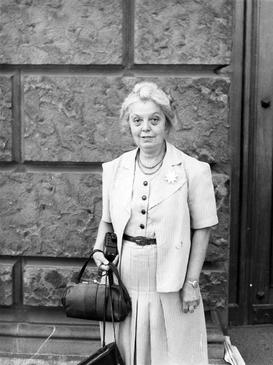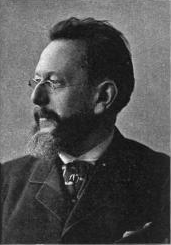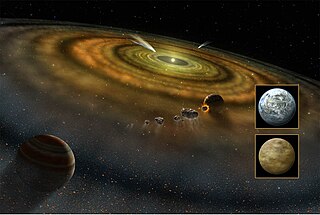Related Research Articles

An astronomer is a scientist in the field of astronomy who focuses on a specific question or field outside the scope of Earth. Astronomers observe astronomical objects, such as stars, planets, moons, comets and galaxies – in either observational or theoretical astronomy. Examples of topics or fields astronomers study include planetary science, solar astronomy, the origin or evolution of stars, or the formation of galaxies. A related but distinct subject is physical cosmology, which studies the Universe as a whole.

Amateur astronomy is a hobby where participants enjoy observing or imaging celestial objects in the sky using the unaided eye, binoculars, or telescopes. Even though scientific research may not be their primary goal, some amateur astronomers make contributions in doing citizen science, such as by monitoring variable stars, double stars, sunspots, or occultations of stars by the Moon or asteroids, or by discovering transient astronomical events, such as comets, galactic novae or supernovae in other galaxies.

The American Astronomical Society is an American society of professional astronomers and other interested individuals, headquartered in Washington, DC. The primary objective of the AAS is to promote the advancement of astronomy and closely related branches of science, while the secondary purpose includes enhancing astronomy education and providing a political voice for its members through lobbying and grassroots activities. Its current mission is to enhance and share humanity's scientific understanding of the universe as a diverse and inclusive astronomical community.

Julie Marie Vinter Hansen was a Danish astronomer. She is the first woman to be obtain a scientific degree in astronomy in Denmark.

Svein Rosseland was a Norwegian astrophysicist and a pioneer in the field of theoretical astrophysics.
Lindsay Atkins Eddie FRAS was a South-African amateur astronomer, known for his observations of Venus, Mercury and Mars and 21 comets. He was elected a fellow of the Royal Astronomical Society in 1880. He saw active military service in South Africa and his final rank was that of a Major.

Knut Jørgen Røed Ødegaard is a Norwegian astronomer formerly employed as a media contact at the University of Oslo's Institute of Theoretical Astrophysics. He was the leader of the Norwegian Astronomical Society (2005–2008), and is also manager of the Harestua Solar Observatory.
The Astronomical Society of Australia (ASA) is the professional body representing astronomers in Australia. Established in 1966, it is incorporated in the Australian Capital Territory. Membership of the ASA is open to people "capable of contributing to the advancement of astronomy or a closely related field". This means that the members are mainly active professional astronomers and postgraduate students. Some retired astronomers and distinguished amateur astronomers are also members, and several organisations are corporate members of the society. The ASA currently has around 600 members. It publishes a peer-reviewed journal, Publications of the Astronomical Society of Australia.

Henrik Mohn was a Norwegian astronomer and meteorologist. Although he enrolled in theology studies after finishing school, he is credited with founding meteorological research in Norway, being a professor at the Royal Frederick University and director of the Norwegian Meteorological Institute from 1866 to 1913.
1646 Rosseland, provisional designation 1939 BG, is a stony asteroid from the inner regions of the asteroid belt, approximately 12 kilometers in diameter. It was discovered on 19 January 1939, by Finnish astronomer Yrjö Väisälä at Turku Observatory in Southwest Finland. It was later named after Norwegian astrophysicist Svein Rosseland.
Kaare Aksnes is a professor at the Institute for Theoretical Astrophysics at the University of Oslo.

Astronomy & Astrophysics (A&A) is a monthly peer-reviewed scientific journal covering theoretical, observational, and instrumental astronomy and astrophysics. It is operated by an editorial team under the supervision of a board of directors representing 27 sponsoring countries plus a representative of the European Southern Observatory. The journal is published by EDP Sciences and the current editors-in-chief are Thierry Forveille and João Alves.
Norsk-Tysk Tidsskrift was a Norwegian periodical, in existence during the German occupation of Norway.

Jens Fredrik Wilhelm Schroeter was a Norwegian astronomer.
Hans Severin Jelstrup was a Norwegian astronomer.
Øystein Elgarøy was a Norwegian astronomer, with a specialty in solar radio astronomy.
Norwegian Genealogical Society is a genealogical society in Oslo, Norway.

Sutherland Astronomical Society Incorporated (SASI) is an amateur astronomical society based in the Sutherland Shire, in the southern suburbs of Sydney, Australia. It operates the Green Point Observatory, it is one of the two founding organizations of the National Australian Convention of Amateur Astronomers, and its members have discovered two comets and two novae.

An exocomet, or extrasolar comet, is a comet outside the Solar System, which includes rogue comets and comets that orbit stars other than the Sun. The first exocomets were detected in 1987 around Beta Pictoris, a very young A-type main-sequence star. There are now a total of 27 stars around which exocomets have been observed or suspected.

The Institute of Theoretical Astrophysics is a research and teaching institute dedicated to astronomy, astrophysics and solar physics located at Blindern in Oslo, Norway. It is a department of The Faculty of Mathematics and Natural Sciences at the University of Oslo. It was founded in its current form by Svein Rosseland with funding from the Rockefeller Foundation in 1934, and was the first of its kind in the world when it opened. Prior to that, it existed as the University Observatory which was created in 1833. It thus is one of the university's oldest institutions. As of 2019, it houses research groups in cosmology, extragalactic astronomy, and The Rosseland Centre for Solar Physics, a Norwegian Centre of Excellence.
References
- ↑ "Hva blir framtida for Norsk astronomisk selskap? – Norsk Astronomisk Selskap". 26 September 2016.
- ↑ "Norsk Astronomisk Selskap dannet". Arbeiderbladet (in Norwegian). 4 March 1938. p. 3.
- ↑ Einbu, Sigurd (7 April 1943). "Norsk populær-astronomisk tidsskrift". Nationen (in Norwegian). p. 4.
- ↑ Heck, Andre (11 November 2013). StarGuides Plus: A World-Wide Directory of Organizations in Astronomy and Related Space Sciences. Springer. ISBN 9780306486029.
- ↑ "Venus Transit in Norway" (PDF). ESO Educational Office. Retrieved 20 December 2022.
- ↑ "About the Norwegian Astronomy Olympiad". Institute of Theoretical Astrophysics. Retrieved 20 December 2022.
- ↑ Livesey, R. J. (1991). "The Aurora 1989". Journal of the British Astronomical Association . 101 (3).
- ↑ Kärnfelt, Johan (2015). "Follow the Information: Comets, communicative practices and Swedish Amateur Astronomers in the Twentieth Century". Journal of Astronomical History and Heritage. 18 (2): 161. Bibcode:2015JAHH...18..161K. doi:10.3724/SP.J.1440-2807.2015.02.05.
- ↑ "Norsk Astronomisk Selskap". Store norske leksikon (in Norwegian). Retrieved 13 January 2023.